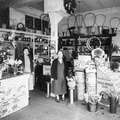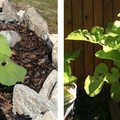Most Yonsei (4th generation Nikkei) and Gosei (5th) are most likely living very comfortable lives with their parents. There may be a Lexus, Acura, and an Infiniti parked in the driveway. Okay, maybe I’m exaggerating. For sure, a Honda Accord, Toyota 4-Runner, and a Nissan Note could be seen in the neighbourhood. The household will have a TV in nearly every room and the children will have an iPhone stuck permanently in their hands, listening to their iPod or viewing YouTube on the iPad. For the Nisei grandparents in the house, they’re probably saying, “I can’t…. I won’t…. I don’t really care!” Hence their memories will turn the clock back 70 years and say, “My, how the world has changed!” Unlike most typical Canadian homes, you know you are Nisei if…
In the 1940s and ’50s, a typical Japanese Canadian home will have a wooden kitchen table and on it, you will see a red tin can of Aji-no-moto (MSG), chopstick container, and shoyu or soya sauce at the center of the table with a type of doily underneath.
At lunch you may see as many as eight children sitting on long wooden benches. The hot rice made in a pot over a wood stove will be in a kama or wooden bowl. Generally Prem or Spam are served with oven-heated iwa nori (seaweed) and denbazuke (New Denver pickles). Children will be crushing the nori between the palms of their hands and sprinkling them all over the hot rice. Of course, soya sauce will be poured over the canned meat.
If wieners are served, they might dab ketchup over them. If the ketchup is empty, father will pick up the kettle from the cast-iron stove and pour a little bit of hot water into the glass bottle. He’ll swish it vigorously and then use every bit of ketchup that is left inside the bottle. Issei parents will inspect their children on how well they ate. They will scold the child if one grain of rice (gohan) was left in the bowl, “If you don’t eat the last gohan in the bowl, you will go blind!” The word “mottainai” was repeated often at the kitchen table.
In the evening, you will invariably be served o-chazuke (tea on cold rice). The home-made tea was most likely made from oven-dried saya endo (snowpeas) stalks. The main meal could be “Kumba-rando chow mein” (Cumberland chow mein). Vermicelli noodles with chicken, celery, onions, and chopped carrots over it. I believe this type of chow mein was invented in the coal mining town of Cumberland, B.C. on Vancouver Island. Denba-zuke (New Denver pickles) was the side dish.
For dessert, children could be eating ame-dama (red ginger candy ball) or chi-chi boru, a tiny round Japanese biscuit that looks like a woman’s nipple. However, karinto was the best! These home-made crackers were deep-fried and glazed with teriyaki sauce and sesame seeds sprinkled over them. No wonder Nisei women wore white aprons all day long, for they spent most of the time preparing meals, snacks, and cleaning pots and pans.
Now, it was time to take a bath. The bath was always located away from the house. It is called Ofuro. The home-made bath was made out of cedar planks, cotton batten chiseled in-between the planks to stop from leaking. Father used an old cast-iron, hot-water tank for stove placed on one end of the 5-foot square bath. Cedar slats covered the tank to protect the bather from getting burned (ya-ke-doh). Once the water became hot, family members would take turns, but the protocol is to use the soap and wash the whole body outside the tub before entering. For those families who didn’t have an ofuro, they would go to the public bathhouse for a ten cent admission.
It was most frightening in the evening when a child had to go to the outhouse (benjo or chozuba in Japanese). Mother or father would take the flashlight to escort the child. It wasn’t scented and if one is lucky a child may see a roll of toilet paper. If not, he would have to rub the newspaper vigorously to soften it enough to complete the job. There was usually a DDT spray-can inside the outhouse. This was to kill off the flies or spiders parked in the corner somewhere. A candle could be lit inside so that you can see where you are peeing into the hole. In the winter, the outhouse didn’t smell as badly, but peeling your long-john flap was hard to do in minus 30 degrees Fahrenheit! A child’s picture of the outhouse in the winter will always be the image of a stalagmite.
When it’s time for bed, a child would get a “yutanpo” (hot-water bottle) in the winter to warm his feet. Home-made quilt or futon was thick enough to keep warm. A pillowcase will most likely be made from recycled rice sack because one can see the faded Kokuho brand on the bleached pillow. Sometimes the weather was so cold that long-johns may not do the job so mothers would knit “keito no dorosu” or sometimes called “sarumata” (woolen boxer shorts) to keep the stomach and the pelvic area warm.
In the morning, a slice of bread could be toasted on the cast-iron stove or with a toaster. A child can see his mother picking the toast with chopsticks. As the child got ready for school, he had to wear jeans where the pant-legs were so long they had to be folded at least four times. A polka-dotted red or blue handkerchief was stuffed in the back pocket.
To add insult to injury, a child had to wear “don-gutsu” or army-styled boots so that they would last a lifetime. The shirts were generally hand-sewn. In a way, it was a blessing because of the wear and tear of highly active children playing all day behind the woodshed. Games like katana-kiri, bang-bang, Peggi, and hopscotch were played and boys fired dust bombs at each other.
In the winter, home-made skis from kindling wood and sleds from boards found in the local sawmill worked just fine with no cost to the parents.
That’s how most of the Nisei children lived during those times of incarceration but they made the most of what they had and did their best to have time to laugh and to enjoy the camaraderie of friends and families who were placed together in an internment camp. I’m sure that was not the intention of the government to create this kind of environment but it was because of the resourcefulness and resiliency of the Nikkei people to rise above and beyond the oppressive situation that was placed upon them.
After 1949, the government allowed the Nikkei people to have the right to vote and to have same privileges as all Canadians. Slowly, Nikkei families returned to the west coast or they moved on to other provinces. One thing for sure, they still maintained their uniqueness of being Japanese Canadians.
As they grew into adulthood, the Nisei became parents and grandparents. There are many signs that you can tell a Nisei because they:
- Still play “gaji” with friends on weekends. This game of hanafuda is uniquely Nikkei.
- Love listening to enka music (Japanese folk songs) and know stars like Misora Hibari and Hashi Yukio.
- Have names like Mas, Tad, Aki, Mits, and English names like Roy, Ken, or George.
- Ladies had names like Sumi, Fumi, Kumi, Mitzi, Chic, and English names like Rose, Mary, Irene, or Ruby.
- Have nicknames like Oats, Fudge, Miso, Bonsan, Yasy, etc.
- Their Issei parents’ names could be: Bumpei, Kumanosuke, Bunkichi, Chotaro, Kingoro, or Hikitaro. Mother’s name could be: Kimi, Hatsu, Noyo, or Koto.
- Can dance the Tanko Bushi (coal miners dance) at Nikkei festivals.
- Save store strings, coffee coupons, wax papers, and Mandarin orange wrappers for toilet paper.
- Know the word “pants caught” and riding underbar.
- Make teriyaki wieners, egg omelette, and seaweed-wrapped onigiri for picnic obento.
- Know what “yaito” means when they have misbehaved. This powder was used to cure adult muscle pains by burning it with incense. To a child, it was a frightful experience.
- Say “a-ge sushi” rather than inari zushi.
- Daikon ashi (radish legs), Hi-kara (trendy), Meki bedo (make the bed), katsudo shashin (movies), baka pay (poor odds), bottera (pancake), Dunburo (basement), omu-stobu (warm stove), and buredo (bread) were commonly interpreted as Japanese terminology.
© 2015 Chuck Tasaka






